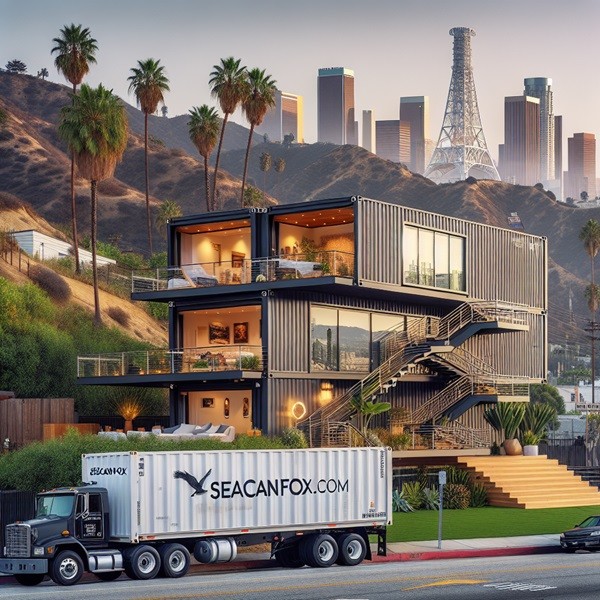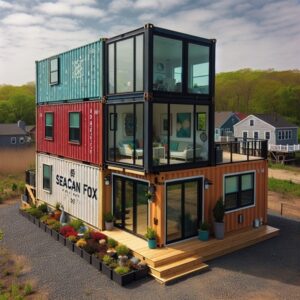
Key Takeaways
- Zoning laws in
dictate where you can build shipping container homes and how they must be constructed. - Before planning your container home, verify that your property’s zoning classification allows for such a structure.
- The permit process for container homes involves submitting detailed plans and navigating various city departments.
- Building codes must be followed to ensure the structural integrity and safety of your container home.
- There may be financial grants available in Los Angeles to help with the construction of your container home.
Table of Contents
My Favorite Container Homes Resource
I compared the top 3 Container Home Guides
to discover the ultimate resource!
See my top recommendation here
Exploring Zoning Laws for Shipping Container Homes in L.A.
Zoning laws are like the rulebook for building in any city. They’re put in place to keep our communities organized and safe. In Los Angeles, these laws will tell you exactly where you can build a shipping container home and the specific rules you need to follow. For example, some areas are zoned for residential use only, meaning you can’t build commercial or industrial buildings there. It’s important to check these rules first, as they can vary widely across different neighborhoods.
Zoning Classifications and Shipping Container Homes
Every plot of land in Los Angeles has a zoning classification that determines its use. Residential zones, commercial zones, industrial zones – each has its own set of guidelines. For shipping container homes, we’re mostly looking at residential zones. But even within these areas, there are subcategories and specific regulations to consider. Here’s what you need to do:
- Check the zoning classification for your property by visiting the Los Angeles City Planning website or contacting the local planning department.
- Understand the specific requirements for container homes in your zone, such as size restrictions, height limits, and property setbacks.
- Review any additional overlay zones or special districts that may impose further regulations on your container home project.
Remember, just because you own the land doesn’t mean you can build anything you want on it. Zoning laws are there to protect the character and integrity of the neighborhood.
Residential Zones and Container Home Placement
Most shipping container homes will fall under residential zoning. In Los Angeles, these are commonly designated as R1 zones for single-family dwellings. But here’s where it gets a bit tricky: even if you’re in a residential zone, you’ll need to ensure that the specific plot of land you’re eyeing is suitable for a container home. This means looking into things like:
- The minimum lot size required for building a home.
- How far your home must be from the property lines, also known as setbacks.
- Any special requirements for parking or landscaping that might affect your design.
It’s all about fitting your container home into the existing puzzle of the community without causing any disruptions.
Adjusting Plans to Comply with Zoning Requirements
Once you’ve got a handle on the zoning laws, it’s time to tweak your plans accordingly. Maybe you’ll need to shift the position of your home on the lot to meet setback requirements, or perhaps you’ll have to scale down your design to stay within height restrictions. Flexibility is key. And don’t forget, your neighbors will appreciate a home that enhances the neighborhood, so consider their perspective as well.
Decoding L.A.’s Permit Process for Container Homes
After zoning comes the permits – the official thumbs-up from the city to start building. Getting a permit for a shipping container home is a bit like putting together a puzzle. You’ve got to make sure all the pieces fit perfectly to avoid any hiccups along the way.
Documenting Your Container Home Project
First things first, you’ll need to document every detail of your container home project. This means creating detailed plans that show the design, materials, and construction methods you’ll use. These plans will be reviewed by various city departments, so clarity is essential. Make sure to include:
- A site plan showing the location of the home on the property.
- Construction plans, including floor plans, elevations, and cross-sections.
- Details on utilities and connections to city services.
This documentation is your project’s blueprint and will be the basis for all discussions with the city, so take your time to get it right.
Navigating Permits: A Step-by-Step Guide
Securing a building permit for your container home involves several steps:
- Submit your plans and any required documents to the Los Angeles Department of Building and Safety.
- Pay the necessary fees, which will vary based on the size and complexity of your project.
- Wait for the plan check process, where experts will review your plans for compliance with local building codes and zoning laws.
- Address any issues or corrections identified during the plan check.
- Once your plans are approved, you’ll receive your building permit, and construction can begin.
Patience is a virtue in this process. It can take time, but it’s all about ensuring that your home is safe and up to code.
Building and Safety Commissions: What to Expect
During the permit process, you might have to meet with the Building and Safety Commission or other city boards. These meetings are your opportunity to present your project and answer any questions the commissioners might have. It’s also a chance for the public to weigh in, so be prepared to discuss how your container home will fit into the community and meet local standards.
Stay tuned for the next sections where we’ll delve into understanding building codes for container homes, securing financial aid, and designing your container home for maximum efficiency.

Understanding Building Codes for Container Homes
Building codes are the nuts and bolts of any construction project, and for shipping container homes in Los Angeles, they’re your blueprint for safety and stability. These codes cover everything from the strength of the materials to the layout of the electrical wiring. They’re there to make sure that your home is a safe place to live, not just for you, but for future generations as well.
- Structural codes ensure your container home can withstand the stresses of being in an earthquake-prone area like Los Angeles.
- Electrical codes are all about safety – preventing fires and making sure all your gadgets have the power they need.
- Plumbing codes keep your water flowing and your home sanitary, avoiding leaks and backups that could cause major issues.
When planning your container home, aligning with these codes is non-negotiable. You’ll need to work with architects and engineers who are familiar with Los Angeles’s specific requirements to make sure your plans are up to snuff. This might seem daunting, but it’s all about protecting what matters most – your family and your investment.
Structural Integrity and Seismic Considerations
Los Angeles is no stranger to earthquakes, so it’s critical that your container home is built to withstand seismic activity. This means using the right materials, securing containers properly to the foundation, and ensuring that the overall design can absorb and resist the forces of nature. Here’s what you need to focus on:
- Choosing the right grade of steel for your containers, which can affect how they perform during an earthquake.
- Ensuring that your containers are properly anchored to the foundation to prevent shifting during seismic events.
- Designing a layout that distributes weight evenly and avoids creating weak points in the structure.
Consider consulting with a structural engineer who specializes in container homes to get the details right. It’s an extra step that can give you peace of mind when the ground starts to shake.
Adhering to Fire Safety and Egress Standards
Fire safety is another non-negotiable aspect of building codes. Your container home needs to have proper egress points – that’s just a fancy way of saying you need a quick and easy way to get out in case of a fire. Smoke alarms, fire extinguishers, and non-combustible materials are all part of the plan to keep you safe. Here’s what to include:
- Install smoke alarms in every sleeping area and on every level of your home.
- Include a fire extinguisher on each floor and in the kitchen.
- Use materials that are rated for fire resistance, especially around heating elements and electrical components.
Ensuring that your container home meets these standards not only keeps you compliant with the law but also provides invaluable safety for everyone inside.
Incorporating Sustainable Practices
Beyond safety, Los Angeles building codes also encourage sustainable building practices. This means considering the environmental impact of your container home and taking steps to reduce it. Think about:
- Insulation that keeps your home warm in the winter and cool in the summer, reducing energy use.
- Windows and doors that seal properly to avoid drafts and keep your heating and cooling systems from working overtime.
- Using materials and finishes that are eco-friendly and sustainably sourced.
Zoning Laws and Permit Requirements for Shipping Container Homes in Los Angeles
| Feature | Description | Estimated Cost |
|---|---|---|
| Zoning Compliance | Ensuring the shipping container home meets local zoning codes such as R-1, R-2, or R-3, which dictate the type of residential units allowed. |
Varies by project |
| Building Permits | Obtaining the necessary building permits to prove compliance with applicable building codes, such as the International Residential Code (IRC). |
$1,000 – $5,000+ |
| Structural Modifications | Making necessary structural modifications to meet the building requirements of local codes, such as the Los Angeles Building Code. |
$5,000 – $20,000+ |
| Permanent Foundations | Installing the container home on a permanent foundation to comply with local building codes. |
$5,000 – $15,000+ |
| Professional Services | Hiring architects, engineers, and contractors to design, certify, and construct the container home according to legal and safety standards. |
$10,000 – $50,000+ |
References:
- dengarden.com – Are Shipping Container Homes Legal in California?
- Container Addict – Are Shipping Container Homes Legal in California in 2024?
- Discover Containers – Container Home Building Codes & Permits
- Los Angeles County – Building Codes for Shipping Container Homes
- Living In A Container – Unveiling the Rise of Container Homes in Los Angeles
- Boxhub – Which States Allow Shipping Container Homes?
- City of Los Angeles – Cargo Container Conversion to Building Modules
Securing Financial Aid: Grants for Your Container Home

Building a home can be expensive, but did you know that there might be financial help available? Grants for housing can ease the financial burden and even incentivize eco-friendly building practices. Let’s look at how you can tap into these resources.
Identifying Grant Opportunities in Los Angeles
The City of Angels offers various grants that can help cover some of the costs of building your container home. These grants might support energy-efficient building practices or help to develop affordable housing. To find these opportunities:
- Visit the website of the Los Angeles Housing and Community Investment Department for information on available grants.
- Look into federal programs like the Energy Star Rebates, which can provide financial incentives for energy-efficient construction.
- Research non-profit organizations that support sustainable housing and see if they offer any grant programs.
Grants can be competitive, but they’re worth exploring as a way to make your container home more affordable and sustainable.
Application Process for Housing Grants
Applying for grants requires attention to detail and a bit of patience. You’ll need to gather all the necessary documentation, which typically includes:
- Your container home plans and specifications.
- A detailed budget for your project.
- Evidence of property ownership and zoning compliance.
Follow the application instructions carefully, and don’t hesitate to reach out to the grant provider if you have questions. A well-prepared application can significantly increase your chances of receiving financial support.
Container Home Grants: Maximizing Your Funding Potential
To maximize your chances of securing a grant, consider these tips:
- Highlight any sustainable features of your container home in the application.
- Show how your project contributes to the community, such as providing affordable housing.
- Be clear and concise in your application, but also thorough – don’t leave any questions unanswered.
Grants can be a game-changer for your container home project, reducing costs and even making your home more environmentally friendly. It’s an avenue worth pursuing for any savvy homebuilder.
Remember, each step in this process is an opportunity to ensure that your home is not just a structure, but a safe, comfortable, and eco-friendly space that reflects your values and lifestyle. So take your time, do your research, and don’t be afraid to ask for help when you need it. The result will be a home that’s as unique as you are, and a place where you can make memories for years to come.
Determining the Ideal Number of Containers
When it comes to building your shipping container home, one of the first questions you’ll face is how many containers you’ll need. This isn’t just a question of size, but also of function. Start by considering what you need from your home: How many bedrooms? Do you want an open plan living space? Will you work from home and need an office? These considerations will help determine the number of containers required for your project.
Optimizing Container Layout for Maximum Efficiency
The layout of your containers is about more than just aesthetics; it’s about creating a functional, livable space. When arranging your containers, think about factors like sunlight exposure, privacy, and the flow of movement within the home. A well-thought-out layout can enhance your living experience, making your home feel larger and more open. It’s also essential to consider how the containers will be connected and reinforced to ensure structural integrity.
FAQs About Los Angeles Container Homes

Building a container home in Los Angeles comes with a unique set of challenges and questions. Here are some of the most common queries from fellow enthusiasts looking to embark on their container home journey.
How Do I Change Zoning Classifications for My Property?
Changing the zoning classification of your property can be a complex process. It typically involves petitioning the city’s planning department, presenting your case to the zoning board, and often, engaging with the community. You’ll need a compelling reason for the change, such as demonstrating that your project aligns with the city’s development goals or that it will benefit the community.
What Are Common Pitfalls When Applying for Permits?
- Submitting incomplete or incorrect plans.
- Not adhering to the specific zoning laws and building codes of your area.
- Underestimating the time it takes for the review process.
- Overlooking the need for additional permits for things like plumbing and electrical work.
Avoid these pitfalls by double-checking your submissions and allowing plenty of time for the permitting process. It’s also wise to consult with professionals who have experience with container homes in Los Angeles to ensure you’re covering all your bases.
Remember, each step in the permitting process is designed to ensure the safety and legality of your home. While it may seem cumbersome, it’s there to protect you and your investment in the long run.
Can I Qualify for a Grant with a Container Home Project?
Qualifying for a grant with a container home project is possible, especially if your project includes sustainable features or provides affordable housing. Research local, state, and federal grant opportunities that align with the goals of your project. Be prepared to demonstrate how your container home meets the criteria of the grant, and be thorough in your application.
Keep in mind that grants are competitive, and securing one can significantly offset the costs of your project. Take the time to craft a compelling application that showcases the unique benefits of your container home.
Do I Need to Follow Specific Design Guidelines for Container Homes?
In Los Angeles, while there are no design guidelines specific to container homes, your project will still need to comply with local building codes and zoning regulations. This includes meeting structural requirements, ensuring proper
It’s important to engage with an architect or designer who is familiar with these regulations to ensure that your container home is both stylish and compliant. Besides that, you’ll want to ensure that your design reflects your personal taste and fits the character of your neighborhood.
Ultimately, the success of your shipping container home project in Los Angeles hinges on a thorough understanding of zoning laws and permit requirements. By taking the time to research, plan, and seek expert advice, you’ll navigate the process with confidence. Remember, this journey is not just about building a house; it’s about creating a home that’s a reflection of your personality and values. With careful consideration and a bit of ingenuity, your container home will stand as a testament to your vision and hard work.





